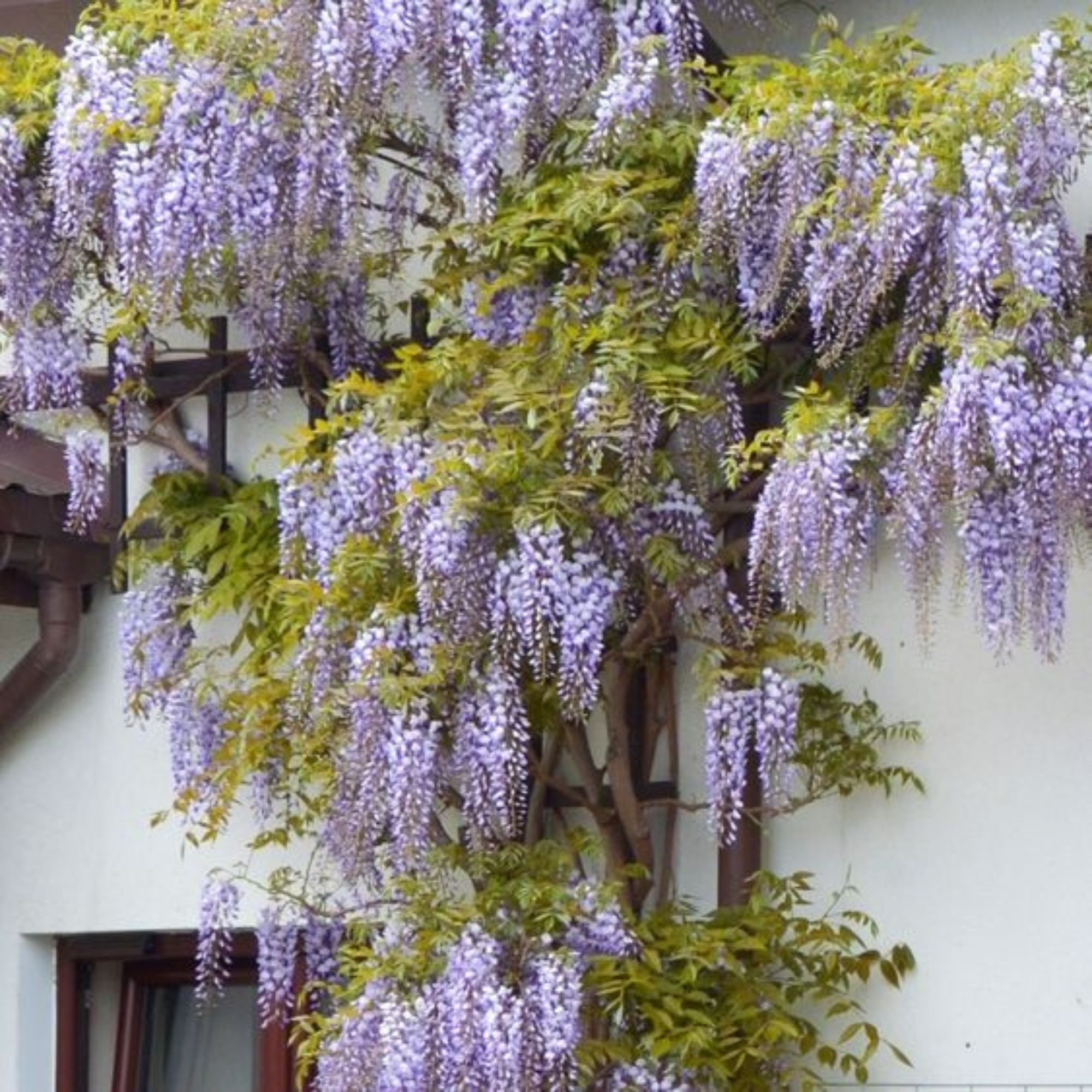
With its drooping purple blooms, it’s fair to say that wisteria has always been a firm favourite. But as Regency-inspired gardens are having a real moment right now, it’s now more popular than ever. However, to grow wisteria you need to know how to train wisteria.
One of the things we love most about wisteria is its versatility. On the one hand, it’s a stunningly beautiful plant that can even increase the value of your property. On the other hand, it’s a fast-growing climbing plant that can be grown in pots, grown as a tree, or trained up a supporting structure.
In fact, training wisteria opens up a world of possibilities to grow this beautiful bloom up your house, your garden walls, or even your pergola. You need to follow certain steps to train wisteria up your support structure of choice, though, and we’ve laid them out in an easy-to-understand guide below.
How to train wisteria

Given the chance, wisteria will grow wild - and it can quickly overpower your outside space. But thankfully, it’s pretty easy to train wisteria and keep it in check. Just follow these four simple steps.
What you'll need
Step-by-step
1. Select your wisteria
While it’s certainly possible to train wisteria in your garden or even on the front of your house, it’s essential to do your research and take some measurements before buying your wisteria plant.
For starters, you need to assess the space you’re working with and realistically decide how big of an impact you want this trailing wisteria to make. If you have a large garden, you can choose whatever size you want. If you lack space, however, it’s probably best to choose one of the best wisteria for small gardens.
Then, you can focus on choosing the exact wisteria plant you want and need from the many plants on offer. Sam Jenkinson from Tiger advises, ‘Choose a young plant that’s healthy as they’re ideal for training.’

2. Choose your support
The romantic purple blooms of wisteria make this plant so popular, which is why you should consider choosing support to help you train wisteria. And while this isn’t essential, this support will ultimately aid growth and blooming as the years go by.
‘Wisteria is ideally grown up a wall, pergola or arch, but it can just be left to grow as it is,' agrees Morris Hankinson, director of Hopes Grove Nurseries. 'If left, it will ramble where it wants to but may flower less over the years.’
So, if you want the flowers to make a real statement, choose one of the following support structures:
Train wisteria up a pergola: There are so many pergola ideas out there, and wisteria is a great way to add colour and texture to what can often be quite a flat surface. Most pergolas are also big and strong enough to take the weight of the plant - such as this Sculpted Wooden Garden Pergola Kit from B&Q - but you need to plant the wisteria properly.
Sam says, ‘When planting your wisteria, you’ll want to do so at the base of a support post leaving around 20cm distance. This will provide your wisteria with space to establish a root system before it starts climbing and give it air circulation around the base of the plant, which will help prevent fungal diseases.’
Train wisteria up garden arches: Arches and arbours are the perfect places to grow climbing plants, and wisteria can turn these arches into spectacular focal points in your garden or along your garden path.
Just remember that a fully grown wisteria plant can become extremely heavy, so you must ensure the arch can take the weight. Something like this Zest Moonlight Wooden Garden Arch from John Lewis would be ideal.

4. Tie shoots to the frame
When you’ve chosen your support structure and planted your wisteria, you may be inclined to let it grow wild. However, this is the worst thing that you could do, as the training steps aren’t done yet.
It’s essential to watch the wisteria plant as it grows and get involved when needed. If you’re growing on a pergola, Sam says, ‘To train your wisteria to climb vertically up your pergola, select four to five healthy shoots near the base of the wisteria, and loosely tie each shoot to the frame for support with garden twine. This will train the plant as it begins its climb up your pergola during the growing season.’
‘Use soft ties that allow for some growth as the stems thicken, avoiding overly tight ties that could strangle and damage the wisteria. You may need to add additional wires and hooks to your pergola so you can guide the wisteria and attach them whilst it grows.’
However, it’s important to note that the same rules apply regardless of your support structure.
4. Prune as the years go by
Before too long, your training efforts will start to pay off. But wisteria can quickly grow out of control and potentially cause structural damage if you don’t keep it in check.
That’s why you also need to keep up with pruning if you’re training wisteria. Sam says, ‘To encourage flowering and to control growth, prune your wisteria twice a year. In late winter, cut back long branches to just a few buds to encourage bushier growth. In late summer, pinch off any vigorous new shoots that might disrupt the overall shape.’
For more info on this, check out our guides on how to prune wisteria and when to winter prune wisteria.

FAQs
How fast does climbing wisteria grow?
Climbing wisteria is an extremely fast grower and will typically grow around 10 feet a year. This all depends on the health and location of the wisteria, though, as some climbing wisteria has been known to grow at least 30 feet a year.
That’s why it’s so important to properly train your wisteria and keep on top of pruning. It’s incredibly easy for the wisteria to overpower the space it's in or the structure it's climbing up. So, make sure you know how to prune wisteria.
Do wisteria grow well in pots?
You can grow wisteria in pots, but it’s important to note that you can only grow wisteria in pots if you grow it as a standard tree. This will limit how well it grows, and may even affect the vibrancy and the amount of flowers that bloom every.
If you want to grow wisteria in pots, just make sure that you pop it in a sunny location, prune it regularly, and maintain a feeding schedule for it.
Now you know how to train wisteria, it’s time to put your training into practice!







